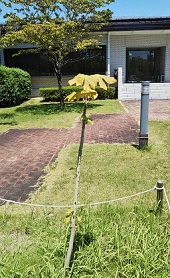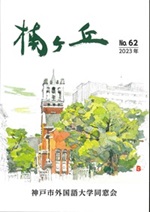リレーエッセー 第21弾
「宮島雛祭り」
広島事務局 俵 博(学12EB)
毎年3月下旬から4月上旬の桜の満開にあわせ宮島で行われる観光イベントに「宮島雛巡り」があります。 宮島の旧家に保存されている雛人形のセットを町家の玄関先、集会所、寺の広間、資料館として改造された古い商家の店先で披露して観光客に楽しんでもらっています。 人形は古いもので江戸末期に作られたものに始まり、明治、大正、昭和と数十セットが島のあちこちで披露されます。
昨年からは宮島を訪れる海外からの観光客にも日本の「雛めぐり」を楽しんでもらうためにNPO法人の主催でボランティアの観光ガイドが募集され、外国人観光客に雛祭り、雛人形の歴史等の説明を始めました。 叉、同時にお寺の庫裡で外国人向けに「折り紙」、「書道」の教室も開催、外国人観光客のみならず、日本人観光客の好評を得ました。 宮島は「原爆ドーム」と共にユネスコによって「世界文化遺産」に登録されたことと、宮島がミッシェランの観光ガイドで四つ星に認定されたことでこの数年外国人の訪問者の数が急増してきております。 勿論宮島及び広島にはプロのガイドさんもおられますがボランティアのガイドは近年増えてきたいわゆるバックパッカーや1人で島を訪れる個人客の観光案内を主たる仕事にしております。 いでたちは宮島の観光ハッピを着て、腕に、「MAY I HELP YOU」と書かれた腕章をして、フェリー乗り場や島内を巡回して観光客を雛人形の会場や折り紙などのイベント会場に案内します。 ボランティアガイドは英会話学校に通う主婦や、英語学校の生徒などで、英語が主要言語です。僅かですがフランス語、中国語等が出来る人もいます。
プロのガイドと違って外国語の会話はつたない部分もありますが、全員学校や英会話学級で習った英語で外国人との交流を最大に楽しんでいる様子でした、プロに無い素人臭さが観光客に概ね好意をもって受け入れられたようです。 中には帰国子女や留学の経験のある方もいるのですが、小生を含めてこのようなセミプロ(?)の人達は素人集団のバックアップをすることで全員参加の協力体制が出来ました。
日本の文化に触れてもらうために企画されたお寺の書院での折り紙教室と習字教室は好評で多くの参加者がありました。 小生は依頼を受けて雛人形の歴史の英文パンフレットを英国人と共同で作りました。 ボランティアガイドをすることでの余禄とでも言おうか宮島の方々と親しくなり。 島の歴史に触れることが出来ました。 厳島神社の宮司さんの奥さんなどからは、厳島神社も終戦後全国の他の有名神社と同様に参拝客が減り経済的に大変苦労したことなど聞かされました。 戦前全国の神社は国家神道のイデオロギーの元で、為政者に利用され戦争に加担したと見做され、戦後暫くは戦犯とも言える存在だったようです。 そのほかに、有名ホテルの女将さんや、土産品店の御主人と親しくなり近頃では宮島に渡ると多くの人から声をかけられる有名人(?)となりました。
下記は英国人と共同で作成した雛巡りのパンフレットです。
MIYAJIMA DOLL-VIEWING TOUR
On March 25 hina dolls go on display at various locations throughout Miyajima. This is a tradition stretching back to the Edo period (1603-1867), while the history of the doll festival itself goes back even further.
Hina means a tiny doll made of paper or clay, and has its origins in hitogata dolls, which were used to exorcise human sins and misfortunes. These dolls were made of paper or straw, and were cast into the sea or river, taking the bad luck with them. Even today the practice of doll-floating remains alive in such places as Tottori, Wakayama, Gifu and Otake in Hiroshima.
Over the ages the dolls became play things, and in the Heian period (794-1185) little girls of court nobles played with dolls houses. Later the date of March 3 became fixed for the event, influenced by a Chinese event held on the first day of the snake.
Sangatu Jyoushi is the first day of snake in March (March 3 by the lunar calendar). On this day, the Chinese would purify themselves and offer food to the gods. The custom spread from the court nobles and samurai classes down to the ordinary citizens. Repeating odd number dates were considered auspicious, so girls'festival was held on the third day of the third month, and boys'festival on the fifth day of the fifth month.
Early in the Edo Period, two or three pairs of paper dolls were simply set against the screen, and hishimochi (diamond-shaped rice cakes) and shirozake (white sake) were offered. By the middle of the Edo Period the male doll in ceremonial clothes representing the Emperor, and the female doll in a twelve-layered robe representing the Empress replaced paper dolls. It became customary to hold a celebration for a new-born baby girl on her first hina festival. Then the tiered platform appeared to display the dolls, and the event was called Doll Festival instead of Doll Play. Parents used to present a set of hina dolls to their daughter when she married, so that she would take them to her new home.
By the end of the Edo period the number of dolls had expanded to include the Emperor and Empress sitting at the top, then the ministers of the right and left, the three court ladies, the five musicians and the guards on the lowest tier. In addition lanterns, hishimochi (diamond-shaped rice cake) and hinaarare (rice crackers) were placed on the platform.
In the Meiji period (1968-1912) this type of display became popular even among ordinary citizens. At the same time the festival was changed to March 3 on the solar calendar instead of the lunar calendar.
Nobody knows for sure when the first hina display appeared on Miyajima. On the third day of April island people used to have picnics in the mountains and on the beaches to celebrate spring. This may have something to do with the doll festival being held on April 3 in Miyajima instead of March 3.
In any case, the doll-viewing tour will give you the opportunity to think about the history and custom of the Doll Festival while you admire the exquisite antique displays.

豪華な2連の雛飾り(宮島の宮司さんの家の所有)
サイトマップ | サイトポリシー | ホームページ管理運営規程
神戸市外国語大学楠ヶ丘会 〒651-2187 神戸市西区学園東町9丁目1 TEL・FAX:078-794-8108
Copyright © 1951 - 2024 Kusugaokakai. All Rights Reserved.







